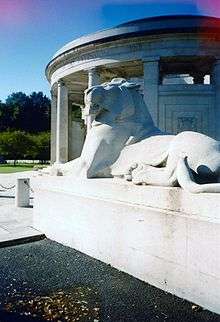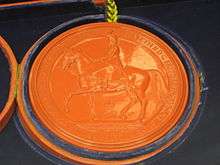Gilbert Ledward

Gilbert Ledward RA (London 23 January 1888 – 21 June 1960 London), was an English sculptor.
He won the British Prix de Rome for sculpture in 1913, and in World War I served in the Royal Garrison Artillery and later as a war artist. He was professor of sculpture at the Royal College of Art and in 1937 was elected a Royal Academician. He became president of the Royal Society of British Sculptors and a trustee of the Royal Academy.
Early life
Born in Chelsea in west London, Ledward was the third of the four children of Richard Arthur Ledward (1857–1890), a sculptor, by his marriage to Mary Jane Wood. His grandfather, Richard Perry Ledward, had been a Staffordshire master potter with the firm of Pinder, Bourne & Co. of Burslem. His father died when Ledward was only two. He was educated at St Mark's College, Chelsea until 1901, when his mother took the family to live in Germany. In 1905 Ledward began to train as a sculptor at the Royal College of Art under Édouard Lantéri, and in November 1910 he proceeded to the Royal Academy Schools.[1]
Career
In 1913 Ledward won both the British Prix de Rome scholarship for sculpture and the Royal Academy's travelling award and gold medal. During the summer of 1914, he travelled throughout Italy, producing sketchbooks now held by the Royal Academy of Arts, but his travels were ended by the outbreak of the Great War at the end of August. He was commissioned into the Royal Garrison Artillery and was later mentioned in despatches.[1][2] In 1917 he was fighting in Italy, and in April 1918 he was recalled to England, to be seconded to the Ministry of Information as a war artist. He produced reliefs for the Imperial War Museum, generally of soldiers in action.[1]
After the war, he was greatly in demand as a sculptor of war memorials. From 1927 to 1929 he was professor of sculpture at the Royal College of Art.[1]
In 1934 he established a company called 'Sculptured Memorials and Headstones', which promoted better design of memorials in English churchyards. The firm's supporters included Eric Gill and Edwin Lutyens.[1]
In 1937 Ledward was elected a Royal Academician, having been an associate of the Royal Academy since 1932. He was seen as loyal to the values of the Academy, a defender of its academic traditions, but also ready to support good modern work. From 1954 to 1956 he was president of the Royal Society of British Sculptors and in 1956 was appointed an Officer of the Order of the British Empire. In 1956 he became a trustee of the Royal Academy.[1]
Work

Drilled in late nineteenth-century conventions, Ledbury remained loyal to representational art. He was strong in composition, less conventional than Gill and less radical than Jagger, and was seen as representing the sculptural establishment.[1]
In 1913 he gained his first major commission, a stone calvary for the church of Bourton-on-the-Water. An early figure in bronze, called Awakening, can be seen in a garden on the Chelsea Embankment.[1]
Ledward's commissions for war memorials after the Great War of 1914 to 1918 included the Guards Division memorial in St. James's Park, London, two lions for the Memorial to the Missing at Ploegsteert, commissioned by the Imperial War Graves Commission, and war memorials at Stockport War Memorial Art Gallery, Abergavenny,[1] Blackpool, Harrogate, and Stonyhurst College (1920), the last of which took the form of a marble altar relief (pictured).[3] Between 1922 and 1925, in partnership with H. Chalton Bradshaw, he created the bronze sculptures for the Household Division's memorial on Horse Guards Parade, Westminster.[4] To the same period belongs his neoclassical marble figure of Britannia for the Hall of Memory at Stockport.[5]

From the late 1920s, he worked less on models to be cast into bronze and more in direct carving of stone,[1] although he made bronze statues of King George V for Kampala, Uganda, in 1939, and for Nairobi, Kenya, in 1940, and another of King George VI for Hong Kong in 1947.[2] His portrait busts in marble include those of Bishop de Labilliere (1944), the actress Rachel Gurney (1945), and Admiral Sir Martin Dunbar-Nasmith VC (1947). His war memorials after the Second World War include one in Westminster Abbey to the Submarine Service, Commandos, and Airborne Forces (1948).[1]
Ledward designed the bronze figures of St Nicholas and St Christopher at the Hospital for Sick Children in Great Ormond Street (1952), the fountain in Sloane Square (1953), the new Great Seal of the Realm of 1953 and the 1953 crown for the coronation of Elizabeth II, of which more than five million were minted.[1] In 1957, he created a memorial to the second Duke of Westminster in St Mary's Church, Eccleston, Cheshire.[2] His last work was a stone frieze with the title Vision and Imagination for Barclays Bank in Old Broad Street, City of London.[1] Wnen the building was demolished in 1995, the frieze was saved from destruction by the Public Monuments and Sculpture Association.[4]
Marriage and death
In 1911, Ledward married Margery Beatrix Cheesman, and they later had two daughters and a son.[1]
He was a member of the Chelsea Arts Club and in Who's Who gave his recreation as sailing.[2] He died at number 31, Queen's Gate, London, on 21 June 1960.[1] He is buried along with his wife in the churhyard of St Mary's, Perivale, Middlesex.
Bibliography
- Peyton Skipwith, Gilbert Ledward: 1888-1960: drawings for sculpture: a centenary tribute: January 25 - February 19, 1988 (Fine Art Society, 1988)
- Catherine Moriarty, The Sculpture of Gilbert Ledward (Henry Moore Foundation in association with Lund Humphries, 2003)
- Patricia Ledward Grandmother's Footsteps a half fact/half fiction tale about the author's grandmother and including many references to her parents: Gilbert (fictional name Bernard) and Margery (fictional name Dorothy). The author herself is named as Vicky. (Macmillan 1966)
Notes
- 1 2 3 4 5 6 7 8 9 10 11 12 13 14 15 Catherine Moriarty, 'Ledward, Gilbert (1888–1960), sculptor', in Oxford Dictionary of National Biography, Oxford University Press, 2004; online edition (subscription required), accessed 9 January 2011
- 1 2 3 4 'LEDWARD, Gilbert', in Who Was Who (A. & C. Black, 1920–2008) online edition (subscription required) by Oxford University Press, December 2007, accessed 9 January 2011
- ↑ Terry Wyke, Harry Cocks, Public sculpture of Greater Manchester (Liverpool University Press, 2004), p. 451
- 1 2 Gilbert Ledward at drawpaintsculpt.com, accessed 9 January 2011
- ↑ Edward Morris, Public art collections in north-west England: a history and guide (Liverpool University Press, 2001), p. 178
External links
![]() Media related to Gilbert Ledward at Wikimedia Commons
Media related to Gilbert Ledward at Wikimedia Commons